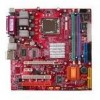MSI 915GM-FR User Manual - Page 64
Introduction
 |
UPC - 816909006445
View all MSI 915GM-FR manuals
Add to My Manuals
Save this manual to your list of manuals |
Page 64 highlights
M S-7033 M -ATX M ainboard Introduction This section gives a brief introduction on the RAID-related background knowledge and a brief introduction on VIA IDE RAID Host Controller. For users wishing to install their VIA IDE RAID driver and RAID software, proceed to Installing Software s ec ti on . Note: RAID option supports only one IDE channel with RAID 0/1 configuration. RAID Basics RAID (Redundant Array of Independent Disks) is a method of combining two or more hard disk drives into one logical unit. The advantage of an Array is to provide better performance or data fault tolerance. Fault tolerance is achieved through data redundant operation, where if one drives fails, a mirrored copy of the data can be found on another drive. This can prevent data loss if the operating system fails or hangs. The individual disk drives in an array are called "members". The configuration information of each member is recorded in the "reserved sector" that identifies the drive as a member. All disk members in a formed disk array are recognized as a single physical drive to the operating system. Hard disk drives can be combined together through a few different methods. The different methods are referred to as different RAID levels. Different RAID levels represent different performance levels, security levels and implementation costs. The RAID levels which the VIA VT6410 SATA RAID Host Controller supports are RAID 0, RAID 1 & JBOD. The table below briefly introduce these RAID levels. RAID Level No. of Drives Capacity RAID 0 (Striping) 2 Number drives * Smallest size RAID 1 (Mirroring) 2 Smallest size JBOD 2 Sum of all drives (Spanning) Benefits Highest performance without data protection Data protection No data protection and performance improvement, but disk capacity is fully used. RAID 0 (Striping) RAID 0 reads and writes sectors of data interleaved between multiple drives. If any disk member fails, it affects the entire array. The disk array data capacity is equal to the number of drive members times the capacity of the smallest member. The striping block size can be set from 4KB to 64KB. RAID 0 does not support fault tolerance. 4-2















